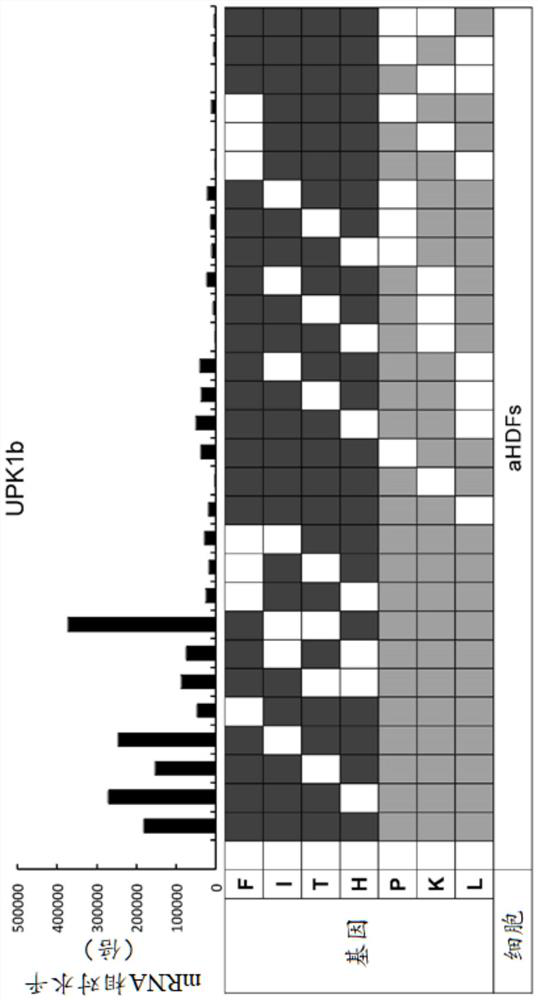Inducer for urinary tract epithelial cells and inducing method for urinary tract epithelial cells
A technology of urothelial cells and cells, applied in the direction of urinary tract/kidney cells, cell culture active agents, botany equipment and methods, etc., can solve the problems of transformation into urothelial cells that have not been reported, and achieve the effect of avoiding canceration
- Summary
- Abstract
- Description
- Claims
- Application Information
AI Technical Summary
Problems solved by technology
Method used
Image
Examples
Embodiment 1
[0296] Adult dermal fibroblasts (aHDFs) are induced to express urothelial-like Phenotype.
[0297] Initially, we focused on three transcription factors. FOXA1(F) and IRF1(I) are important in the development of urothelial cells. On the other hand, TP63(T) is a transcription factor expressed in epithelial stem cells and associated with the development and differentiation of urothelial cells. Additionally, we added the Sonic hedgehog (SHH) gene (H), which is expressed in the basement membrane cells of urothelial cells and regulates signals important for cell proliferation during regeneration. These genes were introduced into adult skin fibroblasts (aHDFs) using retroviral vectors, and the cells were then cultured in CnT-Prime medium for a period suitable for cell maintenance (21 days) ( figure 1 ). In FIT or FIH-introduced cells, uroplakin (UPK1b), which is a developmental marker of urothelial cells, was slightly expressed ( figure 2 A). None of the cells formed urothelia...
Embodiment 2
[0302] Characterization of directly transformed urothelial cells (dUCs).
[0303] Cells transformed by the method of Example 1 are represented as directly transformed urothelial cells (dUC). Next, the detailed properties of the cells were investigated. In the analysis over time, cells transformed with F, T, L, and K significantly expressed UPK1b 8 days after gene introduction, and the expression peaked after 15 days ( Figure 8 a). In FTLK-transformed cells, UPK2 mRNA expression started to rise after 11 days and peaked after 21 days. Epithelial colony formation was observed after 11 days and increased thereafter ( Figure 8 b).
[0304] In addition to the expression of UPK1b and UPK2, the expression of E-cadherin (a transmembrane protein expressed in general epithelial cells) and keratin 8 / 18 (a cytoskeleton) was also confirmed. By immunocytochemical analysis, about 42% of cells expressed UPK1b, on the other hand, UPK2-positive, E-cadherin-positive, and keratin 8 / 12-pos...
Embodiment 3
[0307] Pluripotency, liver and small intestine markers were not expressed in dUCs.
[0308] In order to rule out the possibility that fibroblasts are temporarily transformed into iPs cells or endodermal progenitor cells, and thus give rise to urothelial cells, pluripotency markers in cells introduced with F, T, L, K during the transformation were investigated and expression of non-urothelial endoderm markers. As a result, the expression of NANOG, POU5F1, LIN28, and SOX2 genes was not observed in the cells into which F, T, L, and K were introduced during the culture. The expression of NANOG protein was also not observed ( Figure 10 ). Similarly, at any time of observation, F, T, L, and K-introduced cells did not express the mRNA of the small intestinal epithelial cell marker CDX2 and the liver cell marker albumin (ALB) ( Figure 11 ). In addition, the cells into which F, T, L, and K were introduced also did not express the mRNA of the endothelial cell marker CD31 derived...
PUM
 Login to View More
Login to View More Abstract
Description
Claims
Application Information
 Login to View More
Login to View More - R&D
- Intellectual Property
- Life Sciences
- Materials
- Tech Scout
- Unparalleled Data Quality
- Higher Quality Content
- 60% Fewer Hallucinations
Browse by: Latest US Patents, China's latest patents, Technical Efficacy Thesaurus, Application Domain, Technology Topic, Popular Technical Reports.
© 2025 PatSnap. All rights reserved.Legal|Privacy policy|Modern Slavery Act Transparency Statement|Sitemap|About US| Contact US: help@patsnap.com



